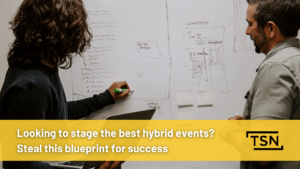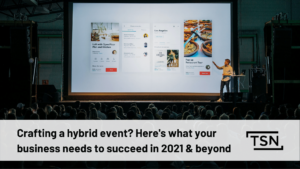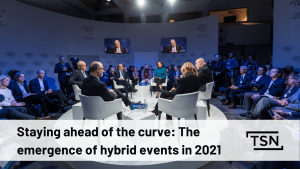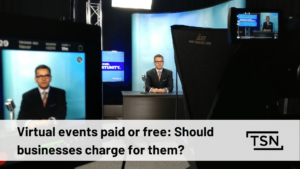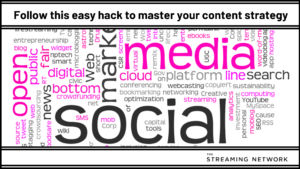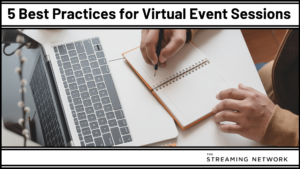According to a recent study, 41 per cent of B2B marketers cite webinars as the best marketing tactic for growing revenue.
However, not everyone knows how to use them effectively. Just getting people to attend your event is not enough to drive conversion. From getting the right audience to nailing your post-webinar outreach, there are many things you need to consider.
We’ve put together this step-by-step walkthrough to demystify the webinar process and help your business capture as many leads as possible.
Getting the right audience
If you want your webinar to be a smashing success, you need viewers. But you don’t want just anybody. If you’re goal is to generate leads for your business, you want people that you can funnel through your sales pipeline and convert into paying customers. The better you target your messaging leading up to your webinar, the more likely it is that you’ll get the right audience.
In the beginning, you only have names. When we’re doing our own webinars, we take the attendee list of prior marketing conferences and actively invite people to participate in our next webinar.
When you do this, your target audience will be relatively small, but well defined and in tune with the content you’re offering. A more granular, aggressive approach like this also helps you avoid list saturation, as you’re targeting specific people that want to be reached.
From here, you’ll want to make sure all the members of your team are in the loop and working towards the same goal. These will include:
- Business Development Representatives (BDR) team
- Sales team
- The marketing department
To maximize the number of invitees for your webinar, try making an additional push through social media.
Webinar reminders and embedding a call to action
Before we can get to the webinar itself, there’s still a little more prep work that needs to be done. As engaging as your content is, not everyone who chooses to register for your webinar will show up. You’re dealing with decision makers with hundreds of competing priorities. That’s why it’s important to send reminders at regular intervals through email and/or SMS text in the days and weeks leading up to the event.
As you reach out to your prospects, it’s important to embed a call to action. We’ve had a great deal of success picking one early on and driving it through the entire process. In our case, we have a Webinar Report Card that we include in our confirmation and reminder emails to registered attendees.
Encouraging audience participation
Once you’ve laid the groundwork for your virtual event, the game is afoot. As we’ve mentioned before, people want to choose how they engage. Make sure the format of your content leaves room for engagement and allows your audience to make use of multiple tools.
Don’t leave it at that. It’s important to go into this believing that audience members may not engage, so you’ll need to prompt them. Think about it. Just because there’s a range of engagement tool available, doesn’t necessarily mean your audience will take advantage or even know why they should use them.
So, what sort of tools should you use? The rule of thumb is to keep it at three. We like to use the following:
- Informational resources
- Polls
- Surveys
There are exceptions, of course. If you have a larger-scale virtual event, where you promise a whole bunch of information, by all means, use more. To help us qualify leads, we keep a tally of engagement and assign each participant a score.
1. Value of informational resources
When it comes to informational resources, we typically include one that is of general interest (i.e., white paper, product platform review or webinar PowerPoint deck), a more specific one (i.e., case study) and an extremely specific piece. You should aim to have something for everyone.
The general interest resource in itself doesn’t tell you much, except that the individual was interested in some general information.
A more specific resource, like a case study, gives you a better idea of where the person’s interests lie. In our webinars, we’ve had studies focused on topics such as saving time and money or demand generation. Anyone who downloads these is clearly interested in running better webinars and can be directed towards additional resources if they want to learn more.
If someone downloads an extremely specific resource, such as our Webinar Report Card, it indicates there’s a need and they are ready to talk to sales. Have a member of your team follow up with these leads.
2. Utilizing the power of polls
Polls have been around forever. Typically, businesses work them into their presentations in such as way where they ask a question, wait for a response and comment on responses. Not all content lends itself to this style.
If you do use polls, ask your viewers questions every 2 or 3 slides, specifically ones that help you qualify them as a prospect, that get inside their head and help drive your narrative. For example, you can ask what their biggest challenges are or even how likely they are to purchase a particular item or service. When you space your polls throughout the webinar, you won’t even need to reference them, as people will click.
The more that your viewers participate, the more of a MQL they become.
3. Incorporating surveys
Surveys are useful but the truth is, people don’t generally complete them. Time is a precious commodity. The two types of people that will typically fill out surveys are the those that are highly engaged and the ones who had a negative experience. It’s, therefore, best to limit your survey to two questions:
- What other topics would you like us to cover?
- How likely are you to evaluate our platform in (specified time frame)?
In every case, you’ll want to evaluate these interactions and direct them to the correct team, depending on the level of interest.
Nailing the post-webinar outreach
Once your webinar is over, there’s still work to be done. You’ll want to thank your attendees with an automatic email and prompt them with next steps. We like to give people 2 or 3 options – contact sales right now, sign up/watch this next webinar and the Webinar Report Card – but the specifics are up to your discretion.
Whatever you decide to include, the primary goal is to get attendees engaged and qualified to be passed over to the sales team. If your viewers didn’t hear enough and are not quite ready, you need to keep them moving through your pipeline by continuing to provide relevant content.
For those that missed the event, you don’t want to give up on these. After all, these people said yes and registered for the event because they had interest. You want to maximize the time and effort you put into promoting. Go back to your initial list for your webinar and prepare a couple emails that prompt them to watch the webinar on demand.
What does success look like?
When it comes to webinars, success will look different for every business. While you want to get as many leads as possible, you don’t want empty calories. Hosting targeted virtual events that zero in on certain industries and sectors will lead to lower numbers but ensures you can hit your KPIs – make sure you have these in place beforehand.
Ultimately, generating leads through webinars is a process. If you need help getting started or you’re still struggling to transform your physical events into successful virtual events in the wake of COVID-19, give us a call or drop us a line via email.

